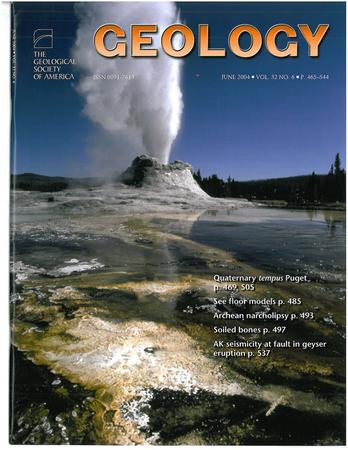A viable Labrador Sea rifting origin of the Northern Appalachian and related seismic anomalies
IF 4.6
1区 地球科学
Q1 GEOLOGY
引用次数: 0
Abstract
The Northern Appalachian Anomaly (NAA) is a prominent low-seismic-velocity zone, ∼400 km in diameter, in the asthenosphere beneath New England (northeastern USA). Previous studies interpreted this shallow feature, occurring at a depth of ∼200 km, as a thermal anomaly tied to edge-driven convection along the North American continental margins. Those studies recognized, however, that upwelling here is highly unusual given that the passive margin has been tectonically quiescent for ∼180 m.y. We propose an alternative model, based on geologic observations, geotectonic reconstructions, and geodynamic simulations, that the anomaly instead represents a Rayleigh-Taylor instability linked to the breakup of the distant Labrador Sea continental margin. A Labrador Sea origin at breakup, ca. 85−80 Ma, would imply the migration of a chain of Rayleigh-Taylor instabilities at a rate of ∼22 km/m.y., close to expected rates from geodynamic models. A migrating-instability origin for the anomaly can reconcile its spatial characteristics, depth profile, and position near a long-inactive continental margin. A corollary is that the north-central Greenland anomaly, a mirror-image of the NAA, also potentially originated at the time of breakup. Further, The Central Appalachian Anomaly may fit this model if it represents an early-stage instability linked to rifting onset in the Labrador Sea. The NAA and other associated anomalies viably represent a legacy of continental rifting and breakup along the distant Labrador Sea margins.阿巴拉契亚北部拉布拉多海裂谷成因及相关地震异常
北阿巴拉契亚异常(NAA)是位于新英格兰(美国东北部)软流圈下方的一个突出的低地震速度带,直径约400公里。先前的研究将这种发生在深度约200公里的浅层特征解释为与沿北美大陆边缘驱动的对流有关的热异常。然而,这些研究认识到,鉴于被动边缘在构造上静止了约180万年,这里的上升流是非常不寻常的。我们提出了一个基于地质观测、大地构造重建和地球动力学模拟的替代模型,即该异常代表了与遥远的拉布拉多海大陆边缘分裂有关的瑞利-泰勒不稳定。拉布拉多海起源于约85 - 80 Ma的断裂,这意味着瑞利-泰勒不稳定性链以约22 km/m.y的速率迁移。,接近地球动力学模型的预期速率。异常的迁移-不稳定成因可以调和其空间特征、深度剖面和靠近长期不活动大陆边缘的位置。一个推论是,格陵兰岛中北部异常(NAA的镜像)也可能起源于分裂时期。此外,如果阿巴拉契亚中部异常代表了与拉布拉多海裂陷有关的早期不稳定,那么它可能符合这个模型。NAA和其他相关异常可能代表了遥远的拉布拉多海边缘大陆裂谷和分裂的遗产。
本文章由计算机程序翻译,如有差异,请以英文原文为准。
求助全文
约1分钟内获得全文
求助全文
来源期刊

Geology
地学-地质学
CiteScore
10.00
自引率
3.40%
发文量
228
审稿时长
6.2 months
期刊介绍:
Published since 1973, Geology features rapid publication of about 23 refereed short (four-page) papers each month. Articles cover all earth-science disciplines and include new investigations and provocative topics. Professional geologists and university-level students in the earth sciences use this widely read journal to keep up with scientific research trends. The online forum section facilitates author-reader dialog. Includes color and occasional large-format illustrations on oversized loose inserts.
 求助内容:
求助内容: 应助结果提醒方式:
应助结果提醒方式:


